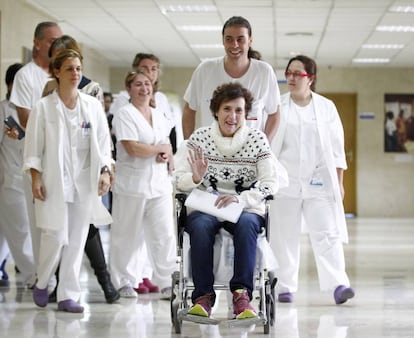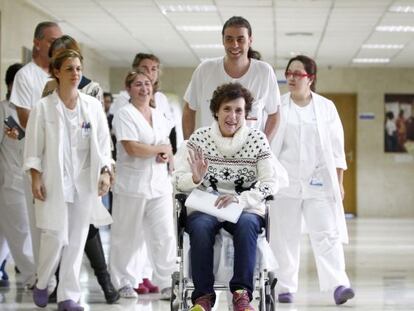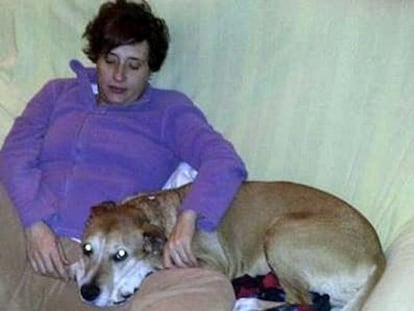Spanish Ebola survivor recalls ordeal: “I felt Death leaning on my shoulder”
Nursing assistant Teresa Romero was the first case of transmission outside West Africa
Teresa Romero, a Spanish nursing assistant, is one of 17,323 Ebola survivors in the world. The latest outbreak killed 11,323 people, or 40% of all cases. The vast majority were infected in West Africa, and suffered from all the dreaded symptoms associated with the disease: fever, unbearable headaches, vomiting, diarrhea, and hemorrhaging from the mouth, rectum and even the eyes.

Romero, a nursing assistant at Madrid’s La Paz-Carlos III University Hospital who had worked directly with Ebola patients, became a patient herself in October 2014. She was the first person to acquire Ebola outside West Africa.
“I felt Death hounding me, like an entity leaning on my shoulder, waiting patiently for me. It is something that cannot be explained with words. Even now, I still don’t know how I made it out of there,” she recalls in a scientific article published in the Spanish-language medical journal Enfermería Clínica.
Far from feeling joy at the news of my recovery, I started crying over my dog, who was executed by health authorities
The article, signed by three specialists of the highly infectious disease isolation unit at La Paz-Carlos III, details the care that Romero received during her 25 days of strict isolation there in Room 6008.
Romero’s ordeal began on October 7, 2014 when she was transferred to the unit within an airtight capsule.
Two months earlier, she had provided medical care for Miguel Pajares, a 75-year-old missionary repatriated from Liberia who had become the first Spaniard to contract Ebola. On September 23, Romero was assigned to a second Ebola patient: Manuel García Viejo, a 69-year-old priest who was infected in Sierra Leone. After he died, Romero cleaned his room.
It was during one of these occasions that she contracted the disease herself, although the exact moment is unknown.
On October 7, the 44-year-old Romero arrived in hospital in a white suit that included gloves and a hood.

“I could barely breathe inside that small space. I was drenched in my own fluids. It was a moment of great anguish,” she recalls.
Three colleagues wearing hazmat suits were waiting for her in the north wing. “Come on Teresa, chin up, we need to have our New Year’s Eve dinner together,” one of them told her.
“It was inevitable to think about the two patients who were repatriated from Africa and whom I had treated, and about their sad end. I saw myself suffering the same fate, I felt panic, I didn’t want to sleep, I felt that if I did, I would not wake up again,” recounts Romero in the article.
On October 8, her health took a turn for the worse. “My lungs began to fail me, I felt like I was choking and could hardly breathe, it was agony. Two colleagues came in to increase the oxygen flow. I begged them to help me die.”
That was when she went into a critical state. She says her memory fades from this moment on.
A month of fear
Until Romero was declared free of the disease – and for several weeks after that – Spain was on alert over fears that the Ebola virus may have spread.
Before being admitted into hospital, Romero had been to see her primary care physician, had made an appointment at the hairdresser's, and walked into the emergency services of another hospital.
Around 20 people who were in direct contact with Romero in the days prior to her admission were quarantined to reduce the risk of an outbreak.
Up to 108 people – 87 women and 21 men – walked into Teresa Romero’s room a total of 352 times during those days, risking their own lives by doing so. Including the two previous patients, the article concludes that 165 hospital workers were exposed to the Ebola virus on 762 occasions.
Despite the small army of professionals watching over her 24/7, and half the country following her ordeal in the news, Romero says she felt alone.
“The rest of the world did not exist; it was just me fighting for survival. I found comfort in the fact that I was connected to an infusion pump with the word morphine written on it,” she recalls.
Another drip was delivering blood serum from a nun who had contracted the disease and survived. At the same time, Romero was also being administered an experimental drug called favipiravir. That was one of the highlights of her day. “I liked it a lot because it tasted good, and since it was dissolved in water and I was really thirsty, I longed for the moment when it was time to take it,” she recalls.
Despite all the medical and scientific effort that went into her treatment, Romero reveals other aspects that she feels helped with her recovery.
“Conditioning factors to overcome the disease: conveying hope, warmth and positive feelings; being able to communicate; not feeling pain; not feeling negative emotions; being able to breathe; being able to sleep; having access to antiviral treatment and blood serum from survivors, although whether this is really effective in treating the disease is under question,” she writes.
Romero was declared disease-free on October 19. But “far from feeling joy at the news, I started crying over my dog, who was executed by health authorities on October 8, 2014,” she writes. Exkalibur was put down by a team from the Complutense University’s Veterinary Health Surveillance Center to prevent the risk of contagion.
“Perhaps I have left out many details; nobody can imagine what I went through in October 2014, except other Ebola survivors,” concludes Romero.
English version by Susana Urra.
Tu suscripción se está usando en otro dispositivo
¿Quieres añadir otro usuario a tu suscripción?
Si continúas leyendo en este dispositivo, no se podrá leer en el otro.
FlechaTu suscripción se está usando en otro dispositivo y solo puedes acceder a EL PAÍS desde un dispositivo a la vez.
Si quieres compartir tu cuenta, cambia tu suscripción a la modalidad Premium, así podrás añadir otro usuario. Cada uno accederá con su propia cuenta de email, lo que os permitirá personalizar vuestra experiencia en EL PAÍS.
¿Tienes una suscripción de empresa? Accede aquí para contratar más cuentas.
En el caso de no saber quién está usando tu cuenta, te recomendamos cambiar tu contraseña aquí.
Si decides continuar compartiendo tu cuenta, este mensaje se mostrará en tu dispositivo y en el de la otra persona que está usando tu cuenta de forma indefinida, afectando a tu experiencia de lectura. Puedes consultar aquí los términos y condiciones de la suscripción digital.
More information
Últimas noticias
Most viewed
- David King, chemist: ‘There are scientists studying how to cool the planet; nobody should stop these experiments from happening’
- Reinhard Genzel, Nobel laureate in physics: ‘One-minute videos will never give you the truth’
- Mexico completes its trade shift with the entry into force of tariffs on China and countries without trade agreements
- Oona Chaplin: ‘I told James Cameron that I was living in a treehouse and starting a permaculture project with a friend’
- Sinaloa Cartel war is taking its toll on Los Chapitos











































